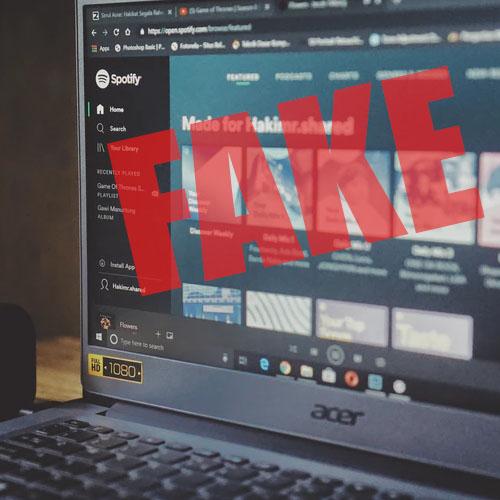
How to spot fake Spotify playlists
A quick round-up of how to discover fake Spotify playlists / illegitimate playlists.
Many artists that are trying to make a name for themselves have considered using Spotify Playlist Promotion to increase their reach. A good idea, if you ask us. Increasing your streams and listeners doesn’t only lead to monetary gain, but also improves your image and popularity as an artist.
Here’s the kicker: there’s a lot of snakes in the grass when it comes to playlist promotion.
Generating streams through active playlists might seem like a good idea (and it is), but it’s not as easy as it seems. Some playlists are entirely made up of fake accounts. These accounts will make your numbers go up, but won’t give you any benefit. In fact, plays obtained through bots are only going to hurt your career as an artist in the long run.
Getting featured in the perfect playlist can be like winning the lottery. If you’re able to effectively utilize the Spotify algorithm for your own benefit, the results can greatly contribute to your success.
At DaimoonMedia, we’ve executed over 8000 campaigns for over thousands of artists. In the process, in addition to learning how to identify legitimate playlists, we’ve also learnt to pin-point the most relevant and best performing playlists.
When we verify the legitimacy of playlists to ensure authentic and organic exposure, there’s a couple of factors to look out for. Here’s a list of the most important signs and tips:
Check the About and ‘Discovered on’ section of artists in the playlist
Spotify tracks who’s listening to your song and where they’re listening from. Interesting to know if you’re an up and coming artist, also useful if you’re trying to verify the legitimacy of a playlist. One of the fastest ways to spot a fake playlist is by checking available data about the playlists, artists and their songs.
If you go to the about section of an artist, you can see where their listeners are from. Check out the cities that are generating the most streams. Fake playlists often make use of data centers in big cities. It’s important to check if all the numbers add up. If the artist has 5k monthly listeners and a big part of them are from a single (seemingly random) city, this is potentially a sign of a fake playlist.

Example of (potential) fake listeners based on location.

Example of real listeners based on location.
In case that you’re still in doubt, you can check ‘Discovered on’. Here you can see the playlists that give the artist the most publicity. Check out all the lists in this section and analyze them for signs of potential fake playlists. An easy tell is if the titles of the playlists don’t match the artists music (for example, the artist makes Hip Hop but the section displays Country playlists).
Be wary: In the past, fake streams used to come from click farms in low income countries. However, these days, fake streams could also come from big cities.
Monitor saves and streams
When your song has received a placement in a playlist, we recommend that you keep track of the streams and saves that the promotion has brought you. Followers of any given playlist are not going to steam all the songs in a row. Instead, they’re going to listen to a couple songs each time. A similar thing applies for saves. Nobody is going to save all of the songs in a playlist they follow, they’re only going to save the songs they genuinely like. So, are you getting a huge amount of streams from a playlist that only has a couple thousand followers? Are you getting suspiciously high or low save rate? Chances are the playlist your song is in, is fake!
Watch out for strange accounts
Have a look at the accounts following the playlist and it’s owner. Do they have strange names and/or follow a number of seemingly random playlists? Time to ring the alarm. Real playlists always have some indication of real people listening to them, the best way to tell is by checking the profiles associated with it.
The curator accepts any song
Does the service you’re considering accept any song, regardless of quality or genre? This should raise some suspicion. Curators are often very selective about the songs they accept for a placement. Who would want to ruin the quality of their playlist by adding under-par music? If you want to be sure, you can always ask curators which artists they’ve worked with in the past and check out their data too.
In addition to this, if you see that a single curator (account on Spotify) has multiple playlists that are all very similar in size, there’s a big chance that those lists are fake. Normally curators have playlists of varying sizes.
Use Chartmetric/SpotonTrack
Another great way to gain access to ‘hidden’ data is by using Charmetric or Spotontrack. These services allow you to check the growth of a playlist, which can be very useful to ensure the authenticity of a playlist. Are there large and unrealistic fluctuations in the growth of the playlist? If so, the playlist is highly likely to be fake. The only exception to this is if the playlist has received a boost in attention through (for example) an influencer shouting it out. However, more often than not, this isn’t the case.
The deal seems too good to be true
Use your own judgement. Do the numbers not add up? Does the account or playlist seem suspicious? Is the offer you received unrealistic? If so, your best bet is to do business with a party that knows what it’s doing and is able to prove that to you.
Hopefully these tips have helped you understand how to identify fake playlists.
If you’re looking for authentic and organic exposure and streams, DaimoonMedia has got you covered. We carefully select our partners and their playlists to ensure real results. Through our extensive network of curators, we are able to offer impressive coverage for most genres.
Interested? Check out our Promotion Options.

